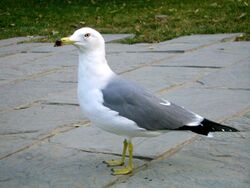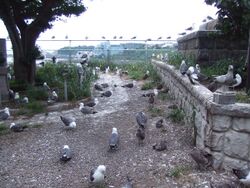Biology:Black-tailed gull
| Black-tailed gull | |
|---|---|

| |
| Scientific classification | |
| Domain: | Eukaryota |
| Kingdom: | Animalia |
| Phylum: | Chordata |
| Class: | Aves |
| Order: | Charadriiformes |
| Family: | Laridae |
| Genus: | Larus |
| Species: | L. crassirostris
|
| Binomial name | |
| Larus crassirostris Vieillot, 1818
| |
The black-tailed gull (Larus crassirostris) is a gull native to shorelines of East Asia.
Description
The black-tailed gull is medium-sized (46 cm) (19 Inches), with a wingspan of 126–128 cm (49.6 - 50.3 Inches). It has yellow legs and a red and black spot at the end of the bill. Males and females have identical plumage and features, although males are larger in size than females.[2] This gull takes four years to reach full adult plumage.[3] As the name suggests, it has a black tail. The bird has a cat-like call, giving it its Japanese name — umineko (海猫, "sea cat"), and Korean name — gwaeng-yi gull, which means "cat" gull. In Hachinohe they are one of the 100 Soundscapes of Japan.[4]
Distribution and habitat
The species is resident to coastlines of the East China Sea, Japan , Manchuria and the Kuril Islands. It is a vagrant to Alaska and North America[5][6] and has been found in the Philippines .[7]
In Japan
The bird is common in Japan, nesting from Hokkaido to Western Kyushu. It has caused flights to be delayed at Haneda Airport in Tokyo.[8]
An enormous gathering of black-tailed gulls can be found at Kabushima, a peninsula (formerly an island) in Hachinohe, Aomori, Japan. A Shinto shrine was raised by fishermen in 1269 (though it has been rebuilt several times since) at which the black-tailed gull, is seen as a messenger of the goddess of the fishery. For over 700 years, the species has enjoyed reverence, feeding and protection from the local population. As a result, every summer, over 40,000 black-tailed gulls nest and raise their young in the grounds of the shrine and the surrounding island, which has been designated a National Natural Monument by the government of Japan. The gulls are very tame and are a popular local tourist attraction.[9]
Around 5,000 birds also nest at Fumi-shima in Shimane Prefecture near Izumo Shrine,[10] and there is a large colony at Teuri Island in Hokkaido.[11]
In Korea
The species is common on the shoreline of Korea and on various islands. There are over 20,000 black-tailed gulls on Liancourt Rocks, and numbers are increasing due to the absence of predators. In 2008, the bird was officially chosen as one of the mascots of Liancourt Rocks.[12] Nando and Hongdo islands, both Korean natural monuments as of 1982, are also known breeding grounds.[13][14]
In North America
A rare visitor to the United States, a black-tailed gull was spotted from Burlington, Vermont, in October 2005.[15] The species has been spotted in Illinois several times.[16]
Ecology
The black-tailed gull feeds mainly on small fish, molluscs, crustaceans scraps and carrion. A study analyzing the identifiable parts of gull excreta in Korea found that 19.1% consisted of the remains of fish, 3.3% of crustaceans, and 3.3% of land insects.[17]
The species often follows ships and commercial fishing fleets. It also steals food from other seabirds. It is a colonial nester, with colonies forming in mid-April. 2–3 eggs are laid by early June. Incubation lasts approximately 24 days.[18]
Black-tailed gulls use a variety of voice signals and are known to use more than 10 different sounds for communication. Young can recognize their parents from their voice and visual stimulation between 10 and 15 days after hatching, and can also distinguish between siblings and non-siblings. Alarm calls are alert signals that warn of predators or danger. Aggressive calls accompany attacks on predators. Contact calls are signals used for intra-specific communication. The most commonly heard cat-like sound ("mew call") is a part of the contact call, and is frequently used, such as when returning to the nest after taking food, alternating the role of the mating and nesting, taking care of the young, collective flight, etc. The sound of a young gull begging for food and the sound of a female during mating are also included in the contact call.[19]
Images
References
- ↑ BirdLife International (2018). "Larus crassirostris". IUCN Red List of Threatened Species 2018: e.T22694289A132538717. doi:10.2305/IUCN.UK.2018-2.RLTS.T22694289A132538717.en. https://www.iucnredlist.org/species/22694289/132538717. Retrieved 11 November 2021.
- ↑ Chochi, Michiyo; Niizuma, Yasuaki; Takagi, Masaoki (2002). "Sexual differences in the external measurements of Black-tailed Gulls breeding on Rishiri Island, Japan". Ornithological Science 1 (2): 163–166. doi:10.2326/osj.1.163.
- ↑ Doherty, Paul. "Black-tailed Gull: a photo essay". http://www.surfbirds.com/mb/Features/black-tailed-gull.html.
- ↑ "残したい日本の音風景100選". Ministry of the Environment. http://www.env.go.jp/air/life/nihon_no_oto/02_2007oto100sen_Pamphlet.pdf.
- ↑ Black-tailed Gull Audubon Field Guide Retrieved April 5, 2016
- ↑ "Black-tailed Gull". http://birdweb.org/birdweb/bird/black-tailed_gull.
- ↑ "Black-tailed Gull Larus crassirostris Factsheet". http://www.birdlife.org/datazone/speciesfactsheet.php?id=3211.
- ↑ Shooing away pesky birds never-ending job at Haneda November 22, 2003 The Japan Times Retrieved April 5, 2016
- ↑ Otaka, Tomoko (22 July 2012). "Power spots and prehistory in beautiful Aomori Prefecture". The Japan Times. http://www.japantimes.co.jp/life/2012/07/22/travel/power-spots-and-prehistory-in-beautiful-aomori-prefecture/.
- ↑ Bamforth, Chris (28 April 2006). "Here be the land of the gods". The Japan Times. http://www.japantimes.co.jp/life/2006/04/28/travel/here-be-the-land-of-the-gods/.
- ↑ Brazil, Mark (5 July 2000). "Migrants and vagrants under Teuri's crags". The Japan Times. http://www.japantimes.co.jp/life/2000/07/05/environment/migrants-and-vagrants-under-teuris-crags/.
- ↑ "Characters of Dokdo". http://k-dokdo.com/index.do?menu_id=00010079.
- ↑ "Natural Monument 334". http://english.cha.go.kr/chaen/search/selectGeneralSearchDetail.do?sCcebKdcd=16&ccebAsno=03340000&sCcebCtcd=34.
- ↑ "Natural Monument 335" (in en). http://english.cha.go.kr/chaen/search/selectGeneralSearchDetail.do?sCcebKdcd=16&ccebAsno=03350000&sCcebCtcd=38.
- ↑ "Black-tailed Gull, Larus crassirostris, Charlotte Town Beach, Charlotte, Chittenden Co., VT, 23 October 2005". http://www.birds.cornell.edu/crows/Black_t_gull.htm.
- ↑ Swick, Nate (12 January 2016). "Rare – Black-tailed Gull – Illinois January 11, 2016". American Birding Association blog. http://blog.aba.org/2016/01/abarare-black-tailed-gull-illinois.html.
- ↑ "Error: no
|title=specified when using {{Cite web}}" (in ko). https://blog.naver.com/koreamof?Redirect=Log&logNo=221120842135. - ↑ Boles, Walter (2009). Josep del Hoyo. ed. Handbook of Birds of the World, Volume 3. Barcelona, Spain: Lynx Edicions.
- ↑ Chung, Hoon (2004). "Communication of young black tailed gulls, larus crassirostris, in response to parent's behavior". Korean Journal of Biological Sciences 8 (4): 295–300. doi:10.1080/12265071.2004.9647763.
External links
- Black-tailed Gulls at Kabushima – official site (in Japanese)
- Black-tailed Gull in California Black-tailed Gull information and Photos in California
- Video showing the gulls of Kabushima
- Video showing the gulls of Kabushima
Wikidata ☰ Q623194 entry
 |







